If you’re intimidated by the very idea of reading the Book of Revelation (the Apocalypse), you’re in good company. I’ll admit: it’s a scary book!
Reading Revelation sends a chill up your spine at times, not just because of its demonic creatures (some of whom bear remarkable resemblances to Washington politicians) but also because it pours out the Wrath of God on evil in very dramatic ways at the end. These aspects of the Bible’s final book give the term “apocalyptic” its real punch.
But take a step back for a second to see Revelation’s wider relevance. It is not just a book of demons and divine wrath. In fact, it is easily the most spiritually uplifting book of the Bible, except for the Gospels themselves. Revelation paints vast canvases of holy imagery to fortify the soul, and in many places, it gives real advice for Christian living.
Angelic Antidotes
So, if you experience anxiety whenever you think about reading the Apocalypse, I have two antidotes to the scariness of the book for you – and both are about angels:
First:
Verse for verse, there are more holy angels in the Book of Revelation than in any other book of the Bible, and some of them radiate astonishing beauty and glory. (My book, Natures of Fire, dedicates several chapters to these awesome angels.)
Second:
The messages to the “angels of the seven churches” in chapters 2 and 3 of Revelation are like mini-courses in holiness for any believer. This is precisely where you should start reading the Book of Revelation.
The following overview will only cite a few lines of these scripture passages, but it’s really meant to be an incentive for you to go directly to Revelation to read about the seven angels and churches for yourself.
In this effort, I have the assistance of the brilliant Louis Comfort Tiffany (1848-1933), who immortalized these holy spirits and their words with seven magnificent stained glass windows.
The Tiffany Angels
The seven Tiffany windows are often called the “Swedenborgian Angels” because they were crafted for a Swedenborg Church in Ohio. (Swedenborgianism is a small Protestant movement based on the writings of an 18th century Swedish mystic named Emmanuel Swedenborg, 1688-1772.)
The story of the windows is almost angelic in itself, a tale of creation, light-filled beauty, followed by obscurity and eventual redemption. The tale was over a century in the telling.
Tiffany Studios in New York created the windows in 1902 for the New Jerusalem Swedenborgian Church in Cincinnati where they glorified the sanctuary of the church for over sixty years. When the city demolished the church in 1964 to build Interstate 71, the parishioners put them into storage in their garages and basements for safekeeping.
There they remained until 1986 when the national Swedenborgian foundation bought them for use in a new church being planned, but the project never came to fruition, so they stored them away again at their rural retreat center in Pennsylvania. Imagine 7 priceless Tiffanies stored in a barn!
In 2001 a new minister found out about the windows and decided to bring them to light once again. By 2003 they were restored to their pristine beauty, and since then the windows have been traveling the country in an exhibition called In Company with Angels, which is the church’s way of sharing the gift of the windows with others.
Truly, the holy angels have protected these windows for over a 100 years! (The brilliant images below are the official photos used in this exhibition. Used with permission.)
The Seven Churches of Revelation
Chapters 2 and 3 of Revelation contain the famous “letters to the seven churches,” which in my opinion are jewels of spiritual strength and enlightenment. The map below indicates the physical location of these seven churches to which the messages were addressed.
The arrangement of the churches from left to r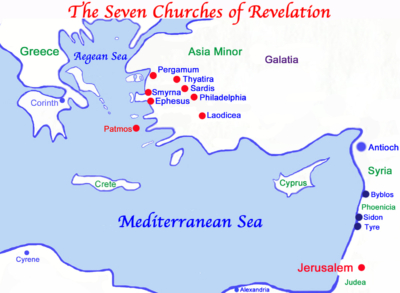 ight forms a rough circle, so it is believed that these ancient cities were a kind of postal route in the Roman Empire. That would be a fitting metaphor for angels delivering messages.
ight forms a rough circle, so it is believed that these ancient cities were a kind of postal route in the Roman Empire. That would be a fitting metaphor for angels delivering messages.
In any case, these cities were places where ancient Christian communities existed, and St. John, the writer of Revelation, puts the messages in the mouth of the Lord Himself, addressing His people very directly.
The messages are both instructive and disciplinary, though in two cases they are meant to console the communities in times of persecution.
The Structure of the Messages
We don’t have space here to analyze these letters in detail (whole books have been written on them!), but I’d like to point out the structure of the letters so you can see the patterns of the Lord’s message to the churches more clearly. There are seven elements to each letter:
- Angel: Each letter is addressed, not to the church directly, but to the “angel of the church” who is tasked with communicating the message – interesting, right? Some scholars take “angel” in the literal sense of the guardian angel of the church itself; others believe “angel” symbolizes the leader or bishop of the church. (Tiffany believed in the literal angels!)
- Address: The Lord identifies the church specifically: “To the angel of the church in Ephesus.”
- Title of Christ: To each church the Lord reveals Himself with a different title that relates in some way to the message He gives them. For example, to Smyrna He calls Himself “The first and the last, who once died but came to life” as a way of encouraging them to stand strong and hopeful through a time of persecution.
- Judgment: The Lord renders judgments on all the churches, some of which are negative and others positive. These judgments have to do with the particular situation of the first century community. For example, the Lord rebukes Thyatira for tolerating a false teacher and destructive influence in their midst, but He also praises Philadelphia for its endurance in suffering for the faith.
- Exhortation: Most of the letters point out some fault of the community and the need to “repent” of it. Like a good spiritual director, the Lord doesn’t leave the fault to guesswork. He tells them what, specifically, they must repent of because it is a danger to their souls. The two churches that have no need to repent, Smyrna and Philadelphia, instead receive exhortations of encouragement in the form of “Stand fast” and “Be not afraid.”
- Promise: The Lord promises spiritual gifts and blessings to each of the churches if they follow His exhortation. Tiffany has taken these seven promises – all delivered with some form of biblical symbolism (as we will see) – and turns them into incredible art.
- Holy Spirit: There is a final exhortation to heed the divine word of the Holy Spirit whose guidance sustains the Church throughout history: ‘“Whoever has ears ought to hear what the Spirit says to the churches.”
The overall impression of these letters is that Christ, the Good Shepherd, is intimately concerned about His Church and about each particular community of the universal Church. He takes care to address their specific failings but also points out their strengths, so that His discipline does not lead to discouragement.
The Lord’s attention to actual human vices and virtues is why we can use these letters for our own spiritual guidance even 2000 years after they were written. In some way they tell our story too. Would that all fathers of families and all pastors of churches gave such diligent, personal care to the souls entrusted to them!
The Windows
Each stained glass window measures 2.5 feet wide x 8 feet tall, and they are full of the brilliant colors, textures, and designs of the original Tiffany school. In fact, when the seventh window was restored, the signature of Louis Comfort Tiffany was revealed in the lower corner of it, indicating that Tiffany himself probably created or designed the windows personally.
In viewing each window, we focus on the “Promise” that Christ makes to that particular angel in the letter addressed to him. Savor the beauty of Tiffany’s feast of angels.
The Angel of the Church in Ephesus
Promise: “To the victor I will give the right to eat from the tree of life that is in the garden of God” (Rev 2:7).
With the thumb and forefinger of his right hand, this angel delicately clutches a branch from the Tree of Life, whose leaves are reflected in a certain way in the pattern of the angel’s tunic (right shoulder).
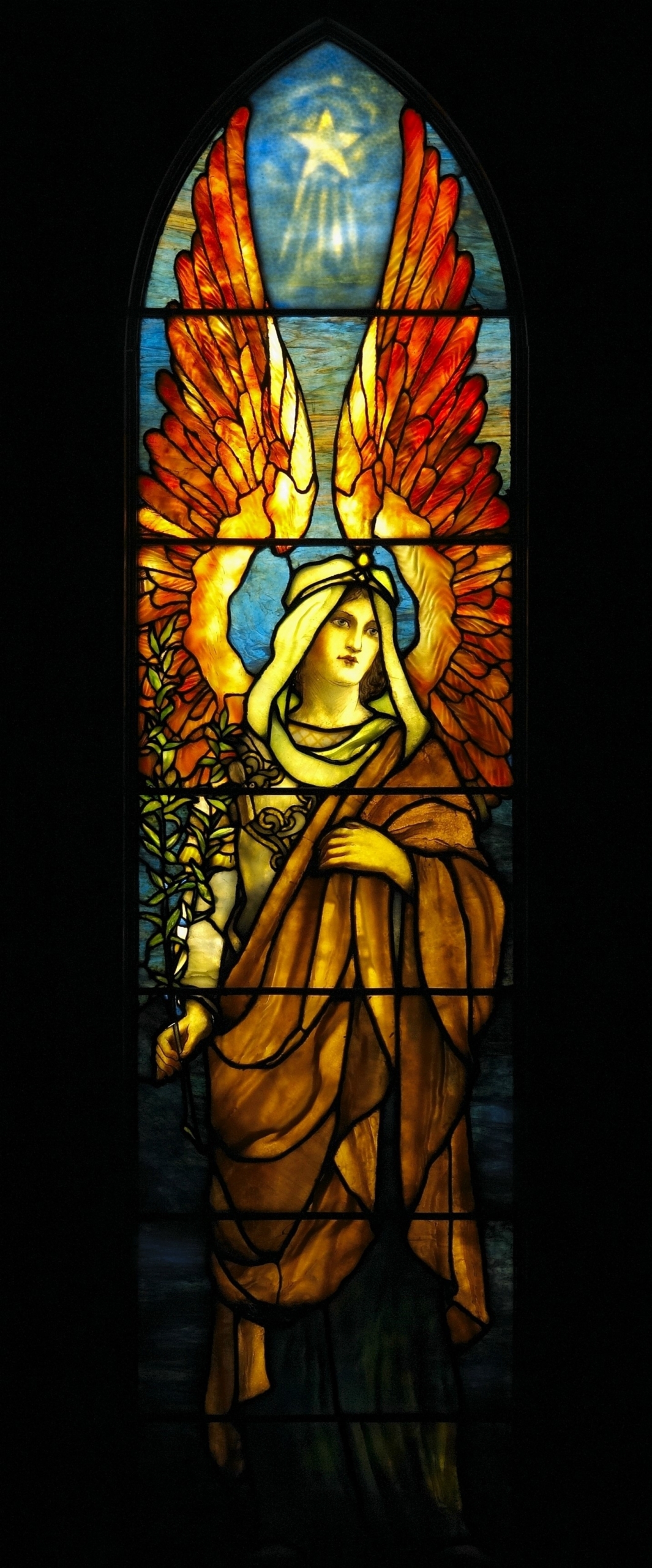
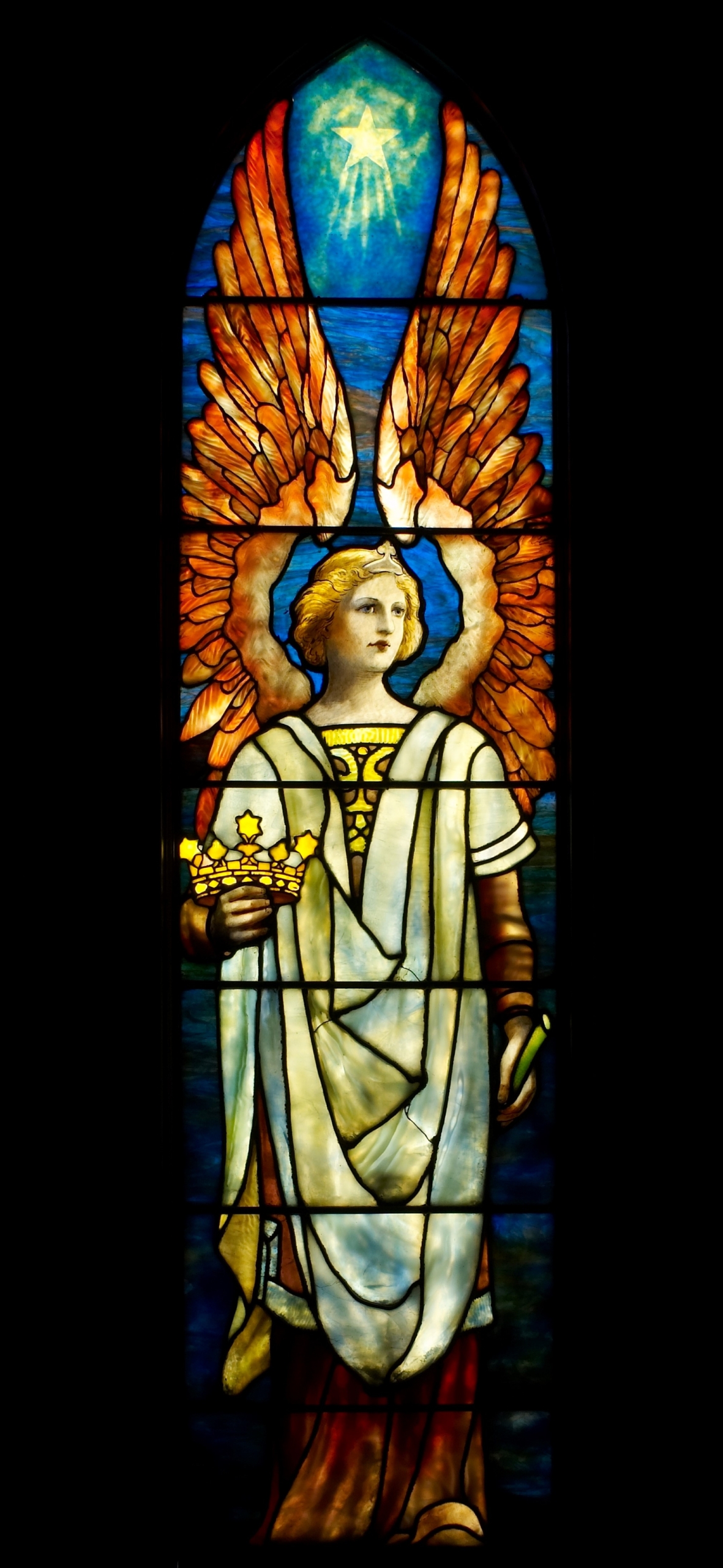
The Angel of the Church in Smyrna
Promise: “Remain faithful until death, and I will give you the crown of life” (Rev 2:10).
The angel presents a brilliant yellow/gold crown with his right hand; this sacred object seems to have its own light source. He is holding a green branch in his left hand, perhaps symbolic of the palm branch of martyrdom that this church is undergoing.
The Angel of the Church in Pergamum
Promise: “To the victor I shall … give a white amulet upon which is inscribed a new name, which no one knows except the one who receives it” (Rev 2:17).
The “white amulet” depicted in this scene is actually a large softball-sized chunk of translucent white glass that Tiffany inserted into the window with all its rough edges. The left hand of the angel firmly grasps something at his side, perhaps reflecting the praise of Christ in the letter for the church that “held fast” to His Name.
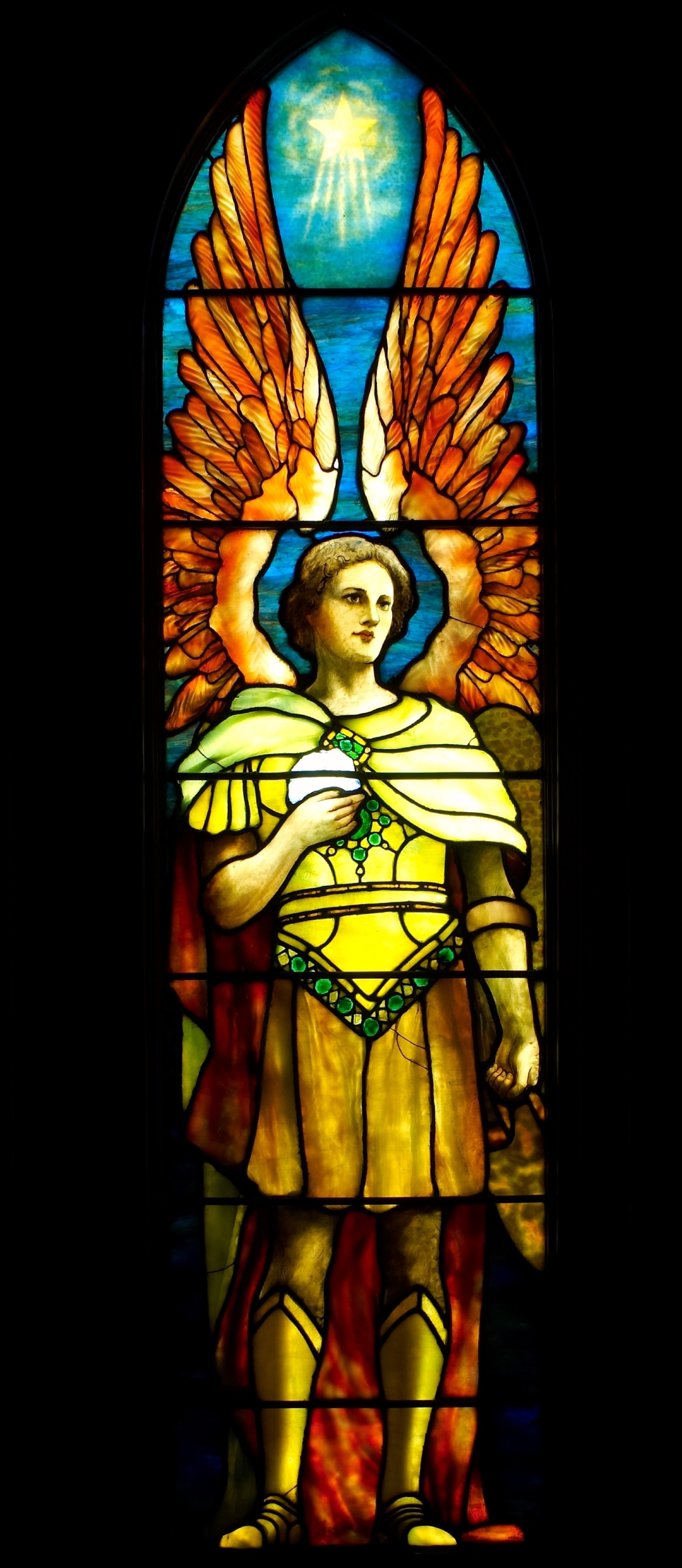
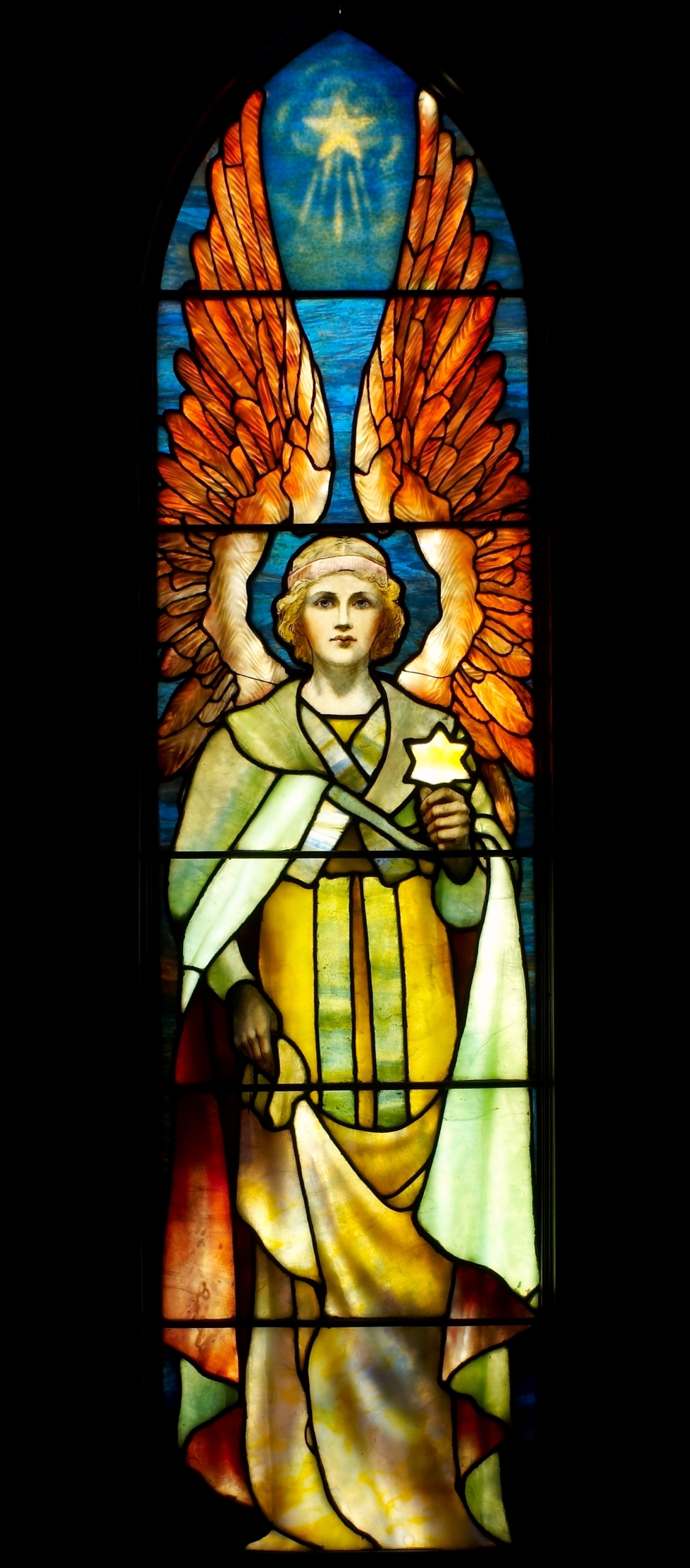
The Angel of the Church in Thyatira
Promise: “To the victor, who keeps to my ways until the end, I will give authority over the nations. … And to him I will give the morning star” (Rev 2:26-28).
This angel wears a crown or diadem indicating authority over the nations and holds a luminous morning star, which Tiffany has beautifully represented as the Star of David.
The Angel of the Church in Sardis
Promise: “The victor will thus be dressed in white, and I will never erase his name from the book of life but will acknowledge his name in the presence of my Father and of his angels” (Rev 3:5).
This angel holds the Book of Life to view with his left hand. The Book is open, symbolizing that the Father acknowledges the names written in it. And this angel is the only one of the seven dressed completely in white, probably in contrast to the message about some church members who had “soiled their garments” by doctrinal compromise.
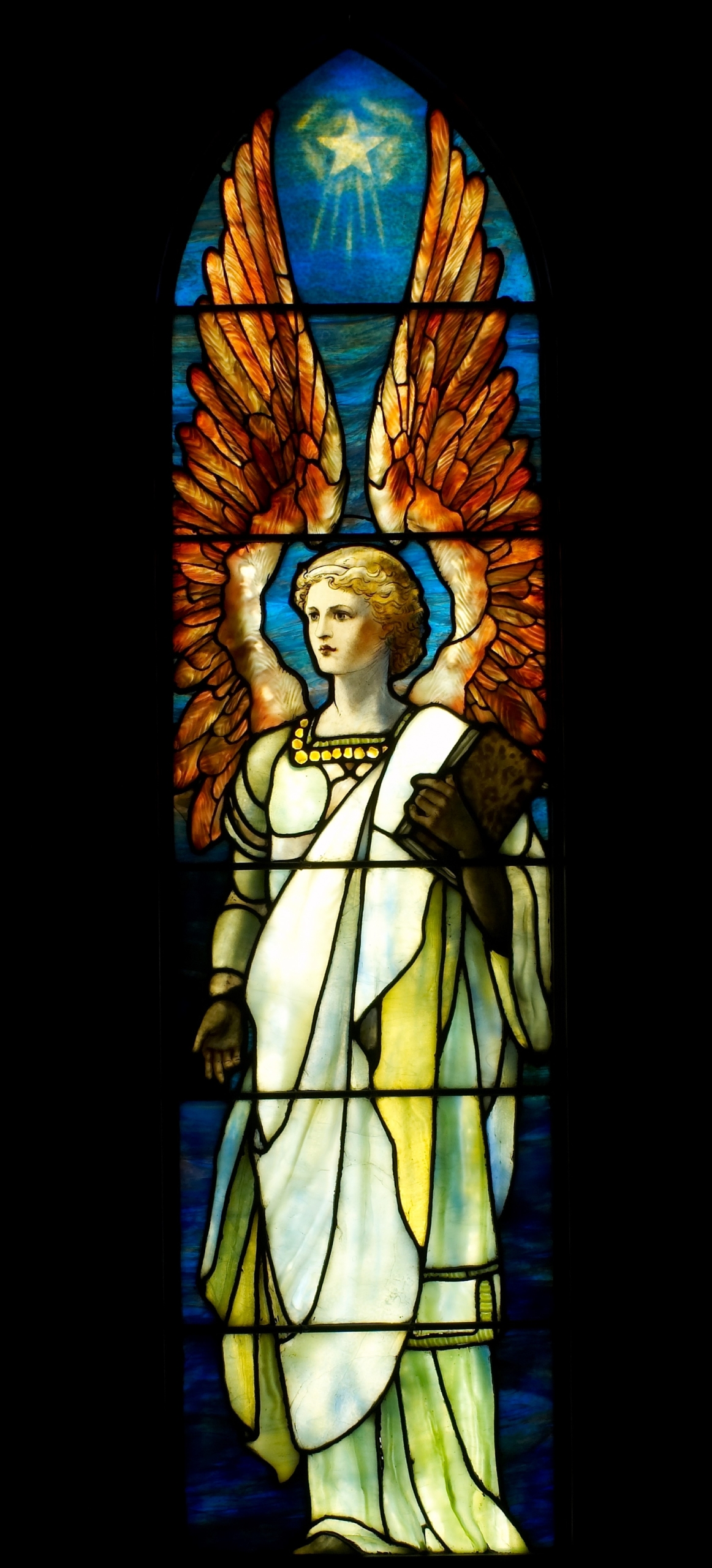
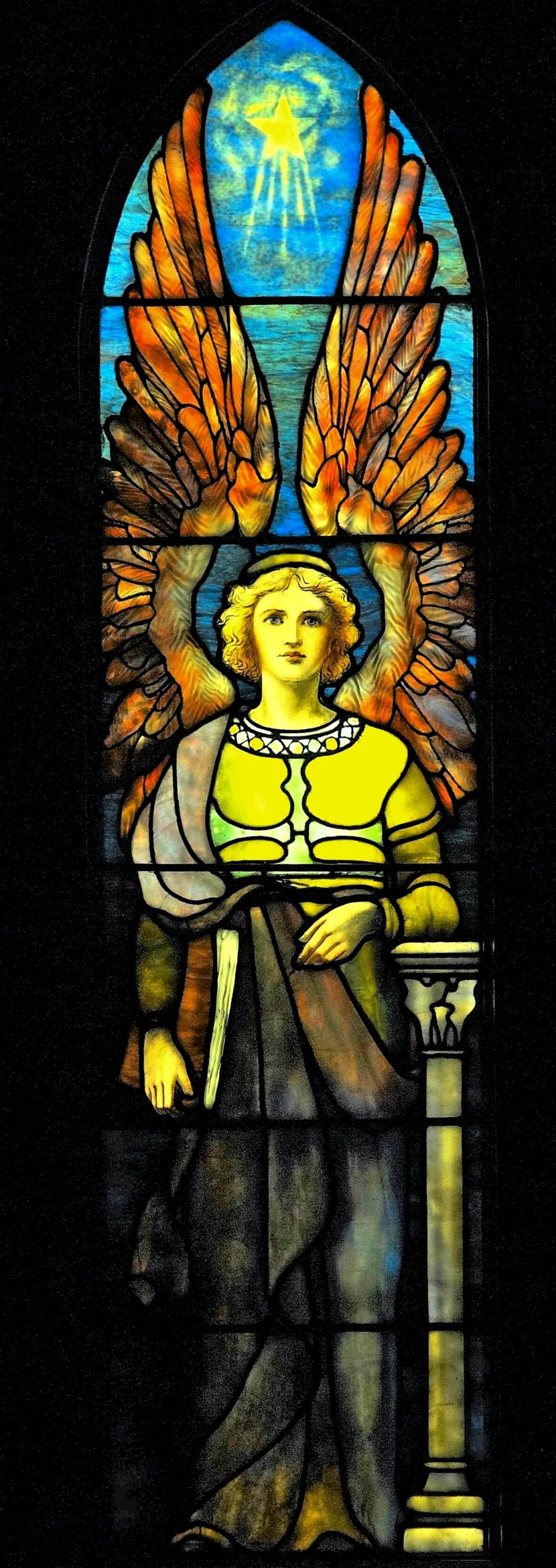
The Angel of the Church in Philadelphia
Promise: “The victor I will make into a pillar in the temple of my God, and he will never leave it again. On him I will inscribe the name of my God and the name of the city of my God, the new Jerusalem, which comes down out of heaven from my God, as well as my new name” (Rev 3:12).
This angel’s left elbow rests on a pillar, while he holds a large closed book in his right hand, perhaps a set of “blueprints” for the New Jerusalem.
The Angel of the Church in Laodicea
Promise: “I will give the victor the right to sit with me on my throne, as I myself first won the victory and sit with my Father on his throne” (Rev 3:21)
The angel holds a scepter in his hand, which a king would grasp as a symbol of his authority when sitting on a royal throne.
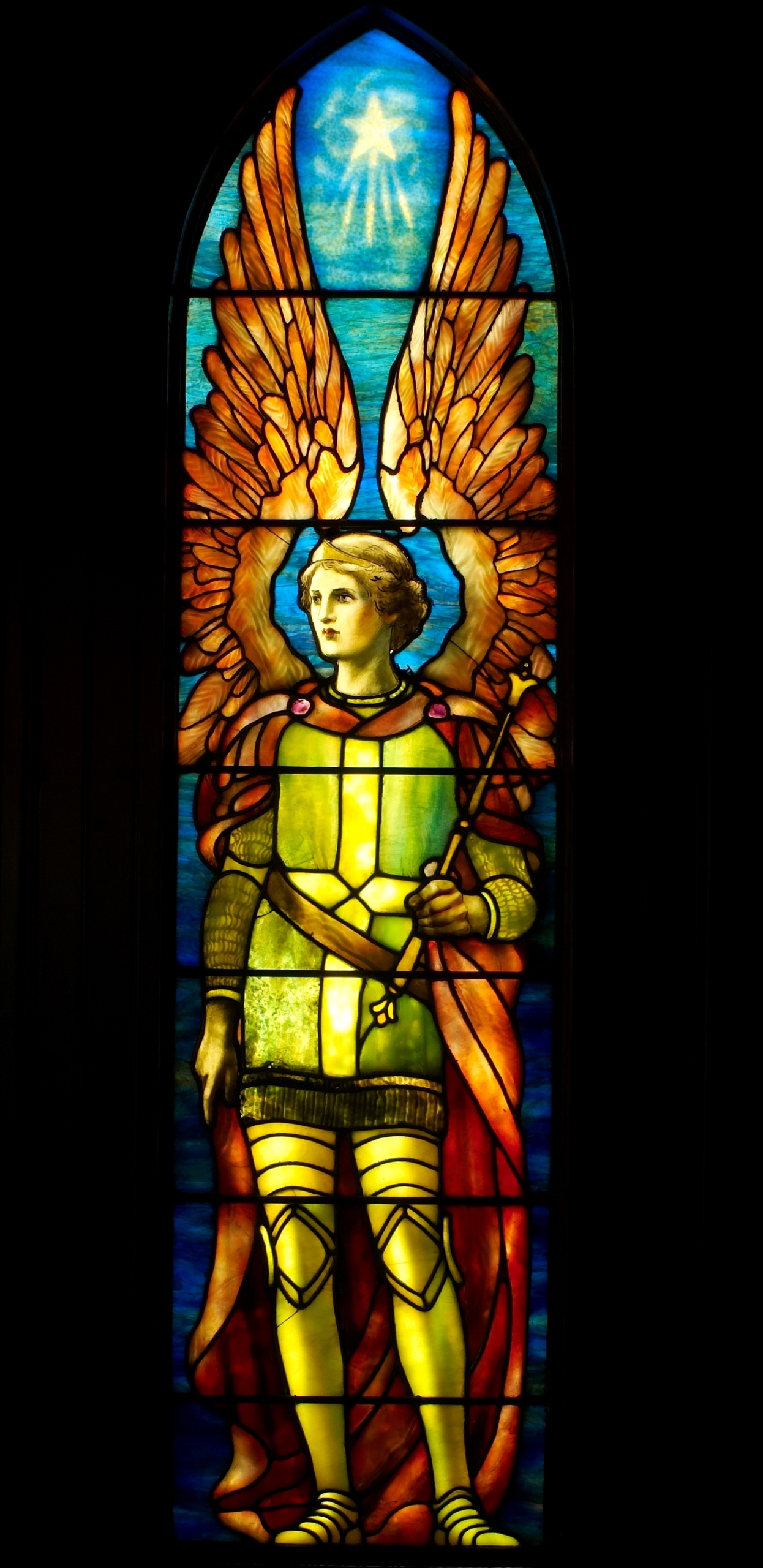
Soul Work
Take time during Holy Week or in the Easter Season to meditate deeply on these letters to the churches in Revelation 2 and 3. They are spiritual jewels, borne to us by the angels themselves who have charge of the churches’ welfare.
Our own guardian angels also have charge of our personal spiritual welfare. They are closer to us than any single human relationship, and they are even more concerned for our spiritual wellbeing that we ourselves are!
Entrust your spiritual journey and the welfare of your soul to your guardian angel, and pray for the grace to listen to his voice and follow his instructions as you make your way to heaven. He knows the way.
As a spiritual exercise, I recommend reading just one of the Revelation letters a day with the purpose of meditating on the message as if the Lord Himself were speaking directly to your soul through His holy angel.
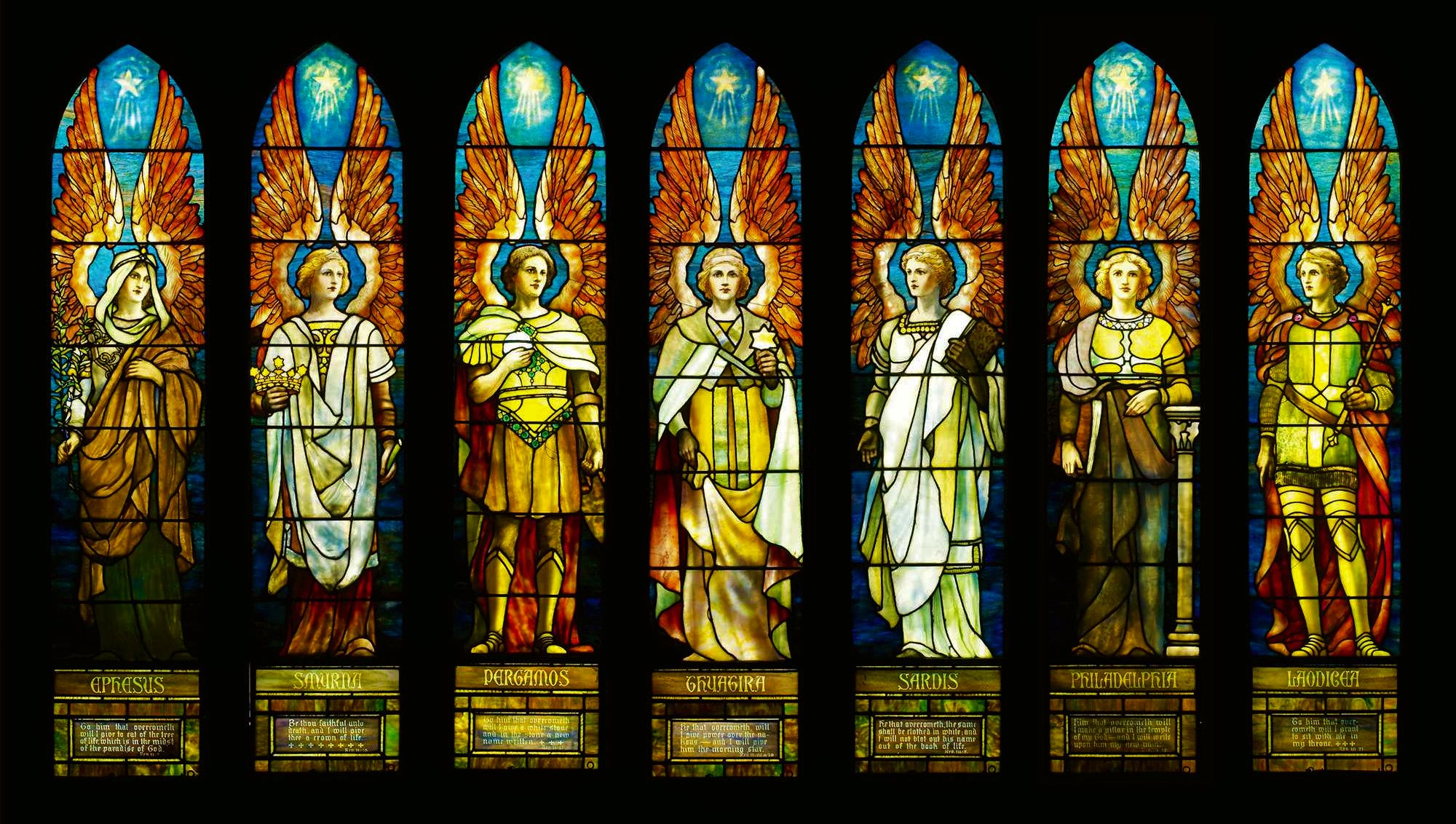
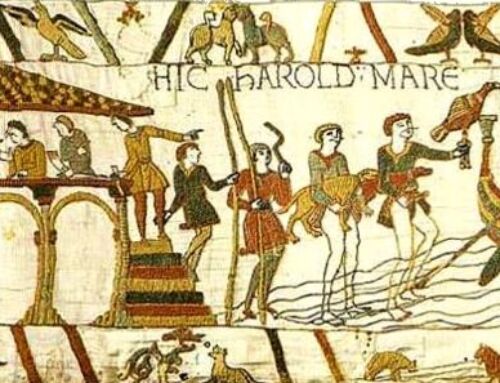


@WhiteHats – thank you for the kind words! If I have any “secret” to writing it is just that I write about things that inspire me, and I always have energy for that! All the best to you and your family this Holy Week.